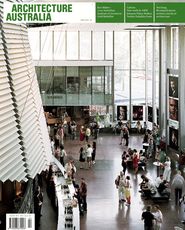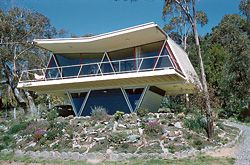
Chancellor and Patrick’s McCraith House, Dromana, 1955. Photograph courtesy of the McCraith family.
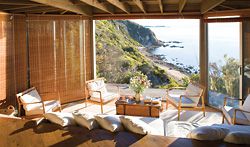
Sea House, Mornington, 1982, by Peter McIntyre.
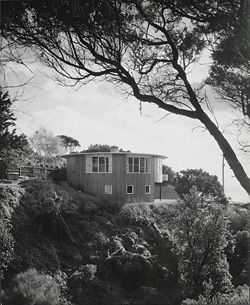
Round House (Henty II), 1953, by Roy Grounds. Photograph Leslie Runting, reproduced with permission of the La Trobe Picture Collection, State Library of Victoria.

Coastal Deck by Baracco + Wright, one of the five Platforms for Living speculative works.
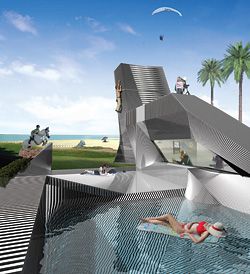
The Nature of Play by McBride Charles Ryan.

Platform for Pleasure by WSH Architects.

Little Wonders’ shimmering virtual peninsula experience.
Melbourne’s architectural culture on holiday. Paul Walker reviews Out of the Square: Beach Architecture on the Mornington Peninsula.
This is an exhibition of photographs, drawings, and other documentation of thirty-four architecturally significant houses and one housing estate plan on the Mornington Peninsula, that district of rural and littoral delights at Melbourne’s doorstep. The houses range from the survivor of Walter Burley Griffin and Marion Mahoney’s tiny Gumnuts pair at Frankston of 1919 to two recently completed McBride Charles Ryan topological investigations. Mostly the houses are post-war: the fifties, sixties and recent trophy houses dominate. This selection suits contemporary taste: postmodernism is not to be seen, as if it never made it to the Mornington Peninsula. Each project is represented by a fascinating mix of drawings, photographs and period comment.
The houses are supplemented by commissioned photographs of Peninsula landscapes, and five speculative designs titled Platforms for Living also commissioned for the exhibition. A handsomely produced catalogue with excellent essays by Conrad Hamann and Lucinda McLean adds a further dimension to the project.
Consisting as it does of these loosely linked pieces, Out of the Square entails several takes on its theme of beach architecture. But the overall driver is a proposition that there is a kind of consistent regional quality extending over a century of architectural endeavour on the Peninsula. Sun, sand and sea, the proposition seems to be, encourage the throwing off of inhibition in lifestyle and in form. This consistent looseness and the experimentation it encourages are proposed by Rodney James, the curator of Out of the Square, to have produced a regionalism of the kind advocated in Kenneth Frampton’s writings or GoMA’s recent Place Makers extravaganza. But James’s borrowing of Neil Clerehan’s phrase “Peninsula Precocious” for the title of his introductory catalogue piece, and the emphatic citation in the exhibition and in the catalogue of the 1952 book Australia’s Home and other texts by Robin Boyd, suggests that perhaps Mornington Peninsula architecture’s regionalism has been produced as much through the power of discourse as it has through building.
Indeed, it is hard to see any consistent peninsula tectonic in the houses documented and the photographs and projects commissioned for Out of the Square, though it is certainly possible to see a certain consistent risk-taking. But this is not specific to the Mornington Peninsula: in Hamann’s essay, the sensibilities cultivated in post-war Mornington houses are linked to related investigations in domestic design operating as far into town as East Kew: it is, after all, a very easy drive from the tip of the peninsula along the Nepean Highway, right into the centre of Melbourne. Hamann moreover suggests that each of Australia’s capital cities has a resort district somewhere in its hinterland with a role similar to the Mornington Peninsula’s in Melbourne’s local design culture. He also makes comparisons with Nantucket and Cape Cod. The disconcerting photograph in the exhibition of Mr and Mrs Walter Gropius visiting Roy Grounds’ Henty House at Frankston in 1954 makes concrete the New England connection, and the connection to experimental modernism.
What differentiates Mornington’s postwar architecture, then, is something a little more evasive than relaxed experimentation; perhaps it is its urgent need to be perceived as relaxed. What Boyd and Clerehan retrospectively discerned in the peninsula’s architecture, and gave shape to in their words, succeeding generations of architects have taken as a manifesto to be fulfilled: experimentalism may not be confined to the Mornington Peninsula but has seemed necessary to recent generations of Melbourne architects when they work there. I suspect this is an imperative also felt by the curator of Out of the Square and his team: the absence of the 1970s and anything pre-Griffin – that is, anything that could not fit readily in a modernist sequence – would be consistent with this.
Not that the show is doctrinaire, as the five Platforms for Living demonstrate. The McBride Charles Ryan project The Nature of Play extends the firm’s recent explorations of complex geometries into a site-specific approach that they call “instantiation”; in Blowhole Paul Morgan looks thirty years into the future to find an architecture responsive to fine ecological nuances. These are the well-known names. WSH, a newish Melbourne partnership, assembles a Platform for Pleasure by investing a small-ecological-footprint building-as-folded-deck with access to a vast virtual environment. Obversely, Little Wonder offers a virtual Peninsula experience, a layered textile screen shimmering and flickering with light effects like sea surface or sky; abstracted from the landscape from which they are derived, they can potentially be enjoyed anywhere. Baracco + Wright’s Coastal Deck proposes a series of modest shelters, each a timber deck with associated amenities just beyond those of a tent, scattered in the coastal bush, that in their presentation is rendered with overwhelming delicacy and particularity. The sensibility and precision manifest here corresponds to the historiographic approach Lucinda McLean takes in her catalogue essay “Everyday Beach Houses” about the modest holiday houses that appeared along the western coastline of the peninsula in the 1950s and 60s – brown bread and butter in comparison to the cake served up in the rest of Out of the Square.
Unfortunately, the venue for Out of the Square is neither bread nor cake, neither the historical local vernacular nor Melbourne’s rigorous architectural culture on holiday. Rather, the Mornington Peninsula Regional Gallery is a meagre institutional building sitting in a new municipal landscape on the wrong side of the Nepean Highway: vestigial urban amenity for the increasingly suburbanized eastern side of the peninsula, indistinguishable from any other outer Melbourne sprawl. Please exit to the carpark: now curate that!
Dr Paul Walker is Associate Professor and Deputy Dean of the Faculty of Architecture, Building and Planning at the University of Melbourne.

